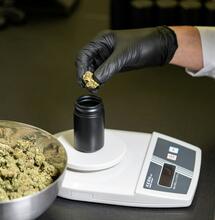Better Buds With Mr. Bill: Mystery Fibers And Stipules

Mr. Bill, our plant fix-it guy, invites you to ask him questions so that you can achieve better yields.
Mr. Bill, our plant fix-it guy, invites you to ask him questions so that you can achieve better yields.
| Cannabis stipules often form an inverted 'V' shape at the internodes. [Credit: Growery.org] |
Mr. Bill is ready to assist you by drawing upon over twenty-eight years of active grow shop experience - including answering growers' questions about the hydroponic industry. Before Mr. Bill opened his first store he worked in the agricultural industry for five years, growing tobacco.
Hello,
My question is: as flowering comes on, I'm seeing these extremely fine white fibers tangled near bud growth - much thinner than hair, more like single strands of synthetic. What are they, from the plant's perspective, and how do they appear? Also, the same questions pertain to those spiky little growths called SPICULES that occur at each node and grow bigger with each branching level - what's up with them?
Dale
Hi Dale,
I have no clue as to what this might be without lots of questions or maybe seeing a picture or two (high-res) of these mystery fibers. It could be the stigma or it could be, as you said, pieces of plastic or synthetic. Some varieties of cactus have fine hairs - are these the types of plant structures to which you are referring?
STIPULES are outgrowths at the base of stems (petiole); they can grow either singularly or in pairs. Some plants have them while others do not. Stipules may appear as glands, scales, hairs, spines or laminar, leaf-like structures. When making cuttings, remove the stipules (since they are a type of leaf) and any other form of growth at the base of the branch, as this can slow down root formation. Leaving vegetative growth on any part of the plant that is placed into your growing medium will slow down the rooting process, as the plant is not sure if it should grow vegetation cells or root cells.
Plants produce many types of cells, but the three most important growth cells are root, vegetation and flowering cells. Plants that have gone into flower must revert to vegetation cells, then rooting cells before roots can begin to form. Then the plant must go back to vegetation cells before proper growth occurs and flowers will develop.
Another potential problem that works on these cells is LIGHT. If you need to reverse your plants from flowering back to vegetation cells, you will see different amounts of leaflets or fingers ('palmate' structures) on the leaves that will begin at five to seven, then reduce to three, then down to one. The leaf development reverses again, eventually resulting in the original five to seven leaves. It can take a few weeks for the plant to fully revert back into the vegetative phase.
Before trying to force flowering, wait until only after you have seen your 'true' sets of leaves come back for at least ten days. This happens in small mother rooms where insufficient light is being delivered to the plants. The plant may have been growing okay under the 400-watt metal halide, when suddenly it starts flowering without you having lowered the amount of light from eighteen hours to twelve. The plant is receiving eighteen hours of light but has started to flower because the plant is 1/100th of the size and is technically getting 1/100th of the necessary amount of light, when all we have to do is force a plant to flower by lowering the 'on' time from eighteen to twelve hours. Now the plant starts flowering with only a third of the amount of light.
Prune carefully when getting ready to begin the flowering process, as it is the new growth that detects the amount of light being received, not the older growth that has seen many a day. You would think that the older leaves would be the ones telling the plant it is time to start flowering because of the lack of light, but that is not how it works.



